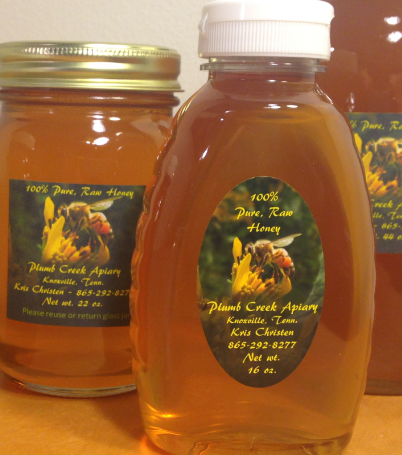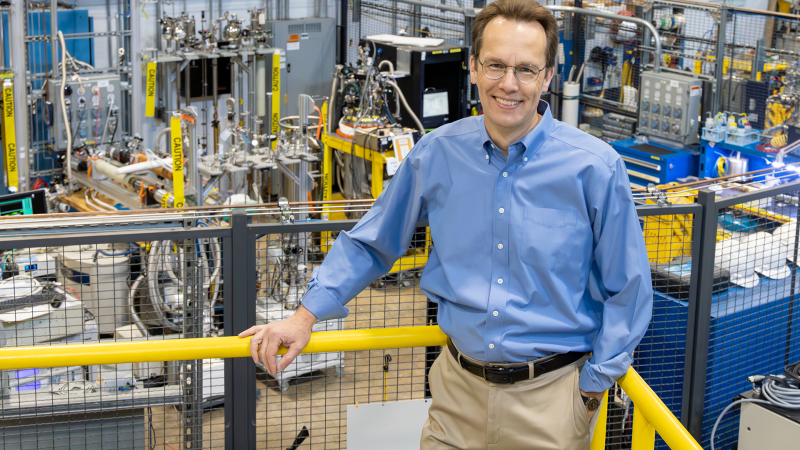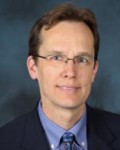When Hans Christen was completing his doctoral studies at the Swiss Federal Institute of Technology in Lausanne, Switzerland, little did he suspect that his studies in materials science would eventually lead him to managing countless skilled, industrious and highly organized workers in Tennessee – his honeybees.
Along with his wife, Kris, a former science writer and editor at ORNL, the two have been keeping bees for 12 years and selling their award-winning honey under the Plumb Creek Apiary brand at local farmers markets around Knoxville.
“Beekeeping has an almost meditative aspect, in that you want to work around them in slow motion so as not to get them riled up,” said Hans. “I find it’s a good means of getting away from the hustle of the job.”

Hans has certainly hustled at work during his more than 30 years as a research scientist and manager. Now, as he prepares to retire from ORNL – his last day in the office is June 23 – Hans, a Fellow of the American Physical Society and author of more than 150 scientific publications and several patents, has been reflecting on how his career has taken him on quite a journey.
“I’m the first scientist in my extended family. Everyone else works in farming or as pastors, schoolteachers, nurses and such. My father actually retired early so he could dedicate his time to his art as a painter. My own career grew out of a natural sense of curiosity and creativity, by which I mean I didn’t have a definite plan in mind, but I benefitted from a series of very fortunate employment opportunities.”
After working in thin-films development as a graduate student with IBM Research in Zurich, Hans began looking at postdoc positions in Europe. His professor at the Swiss Federal Institute of Technology, who had previously worked at ORNL as a postdoc, suggested Hans also look there for work.
Even though Hans had no idea where exactly Oak Ridge, Tennessee was, he soon had a job offer and started at ORNL as a postdoctoral fellow in 1994 working on ferroelectric films.
Two years later, Hans was recruited to work as a staff scientist at Neocera, a small start-up company in Beltsville, MD. The high-tech company was developing solutions for manufacturing thin films, including pulsed laser deposition and pulsed electron deposition systems. During his stay there, the high-tech firm grew rapidly and Hans found he was getting pulled away from his research to manage other researchers.
“It was exciting to work in that entrepreneurial environment, but at the time I wanted to avoid management. So after four years, when a staff scientist position opened up at ORNL, I decided to return there.”
That staff position opened when David Norton, a senior research staff member at ORNL, was leaving to take a position elsewhere. He recalls being asked if he could recommend anyone for his job.
“They asked me who they should hire and I told them the best person would be Hans Christen, because he’s fantastic, knows the system and is great to work with.” Norton laughed at the memory and added, “What I didn’t expect is that Hans would get my laboratory, he got all my equipment, my office, and he even got my old phone number!”
Hans thus rejoined ORNL in 2000, focusing once again on thin-films research, and in 2006 he was chosen to lead the Thin Films and Nanostructures group. He focused his research on the effects of epitaxial strain, spatial confinement and interfacial mechanisms on the properties of complex-oxide thin films. Subsequently, he was named manager of the DOE Materials Sciences and Engineering Program.
In 2014, ORNL was looking for a new director for the Center for Nanophase Materials Sciences, one of five DOE Nanoscale Science Research Centers.
Hans was soon named director of the CNMS. During Hans’ time at CNMS, the center’s funding increased, the number of publications went up significantly, and the scope broadened to strengthen the electron microscopy effort. Hans also increased collaboration between the CNMS and the scientists at the Spallation Neutron Source.
Most recently, since September 2018, Hans has served as the director of the Neutron Scattering Division within ORNL’s Neutron Sciences Directorate. He has helped grow the division while successfully guiding it in its mission of providing scientific and technical expertise to support and develop world-class neutron scattering user facilities.
During Hans’ time at NSD, the SNS and HFIR user program has thrived despite extended outages at both sources and the absence of on-site users during the pandemic. Also, remote experiments are now possible across the entire instrument suite, and significant milestones in software and sample environments have also been reached. As a result, the program’s scientific output per instrument now exceeds other leading neutron facilities.
Hans has helped oversee an impressive number of ongoing instrument improvements in addition to helping launch a number of new projects, including VENUS, the new imaging instrument under construction at the SNS. More recently, thanks in part to strong leadership, staff expertise and collaboration, a clear vision for expanding HFIR’s cold-guide instrument suite has been established, which will strengthen plans to operate HFIR for decades to come.
Hans is known for his friendly management style and his ability to make all of his employees feel appreciated. Several years ago he initiated an annual awards program for NSD staff, including researchers, postdocs and administrative assistants. This popular event includes competitions for Best Neutron Research Paper and Best Neutron Science Experiment. After the candidates make their presentations, attendees cast ballots for their favorite in each category.
The event also includes announcements of awards for NSD Postdoc of the Year, Neutron Spirit, Doing it Better, Outstanding Technical Support and Outstanding Administrative Support. Each NSD winner in the seven categories receives a certificate of recognition and a trophy.
The awards ceremonies help keep morale high among NSD staff and ensure that everyone in the division knows their efforts are appreciated. This event is something that Hans always looks forward to and helps plan the ceremony details. He understands that being appreciated for the work they do is an important part of maintaining an effective and productive workforce.
“Looking back, I realize that my biggest scientific impact has probably been in making sure other scientists and the organization as a whole have a supportive environment and the resources and structure needed to produce research that benefits the world. I guess it’s a little like keeping bees – you make sure your amazing workers have sufficient resources and a top-notch environment so they can produce a world-class product.”
Hans and Kris reside in Knoxville, Tennessee. In addition to beekeeping, both in Knoxville and in Wartburg, they enjoy hiking and other outdoor activities. – by Paul Boisvert






